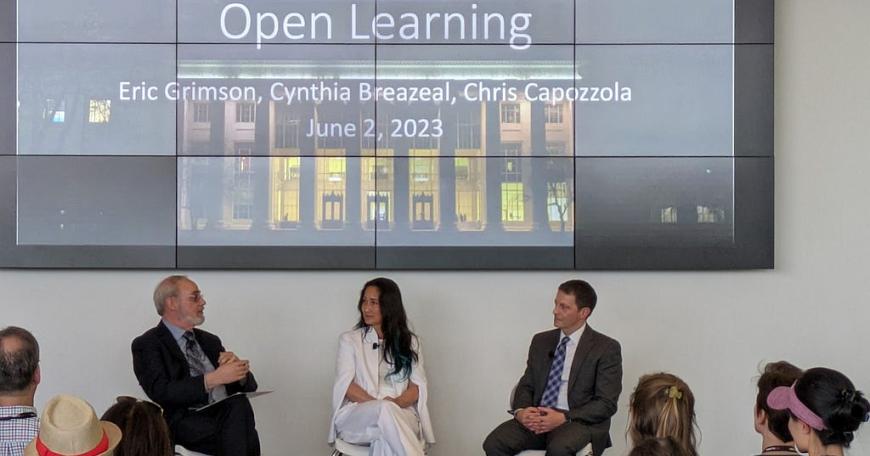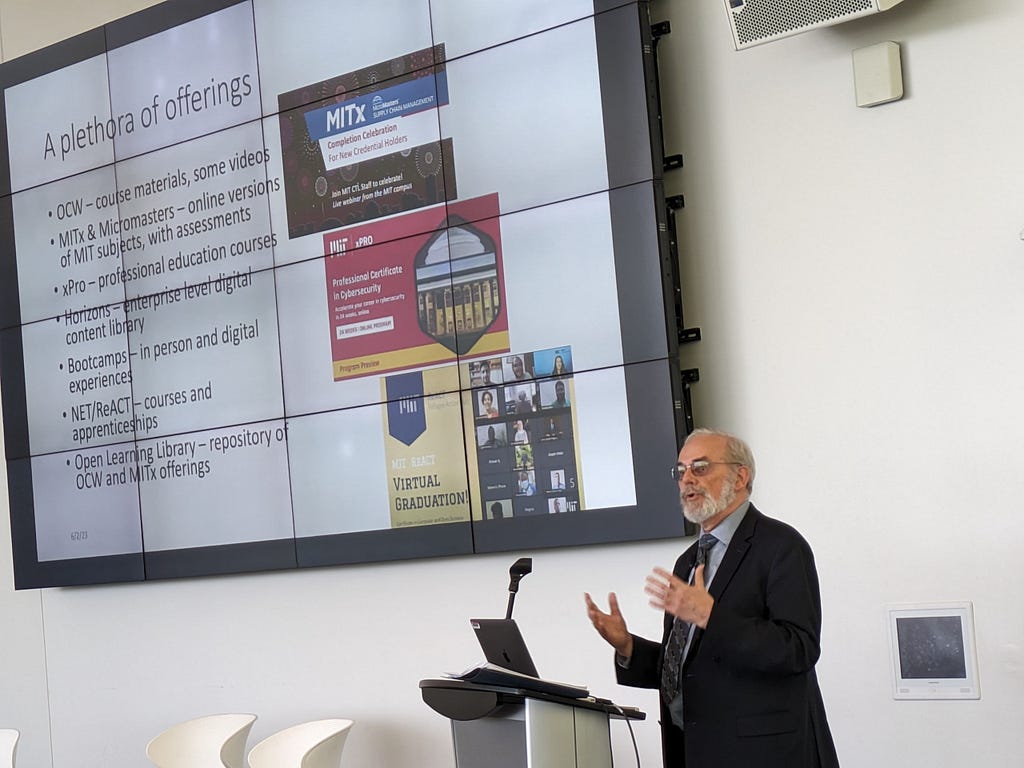
How advanced technologies are transforming education
MIT leaders and professors Eric Grimson, Cynthia Breazeal, and Christopher Capozzola discuss challenges and opportunities of AI in education
By Duyen Nguyen
Spurred on by the rapid advancement of generative AI like ChatGPT, much of the current conversation on artificial intelligence has emphasized its threat to humanity. Yet, this technology and other recent innovations also hold promise for the future.
“Today’s technologies in education — generative AI, responsible design, and the future of learning,” was a recent event hosted on MIT campus by MIT Open Learning. As part of the MIT Tech Reunions, this session welcomed over 60 alumni and friends. Vice President for Open Learning Eric Grimson, Dean for Digital Learning Cynthia Breazeal, and Senior Associate Dean for Open Learning Christopher Capozzola discussed both the challenges and opportunities that AI presents in education. Here are some of the most important takeaways from their conversation.
Technology is reshaping residential education
With MIT faculty dedicated to innovating in the classroom, digital tools have been a mainstay of on-campus teaching. Technologies like automated grading in computer science courses enable more time for teaching staff to interact with students, while students are able to correct their learning with immediate feedback on their problem sets. Prof. Grimson pointed to some of these technologies in improving residential education even before the Covid-19 pandemic necessitated a temporary shift to remote learning.
But remote learning pivots have expanded approaches to residential education. For example, using the Zoom chat feature to ask and answer questions during lectures allows more timely opportunities for students to clarify their understanding and engage more deeply in the subject matter and with their classmates. Faculty also gain a better sense of where students need bolstering in mastering concepts. The adoption of blended learning (a mix of in-person and online learning) would make it easier for students to pursue internships and experiences abroad while still receiving an MIT education, said Breazeal, Capozzola, and Grimson.
MIT can expand its role in education globally by leveraging today’s technologies
Several of MIT Open Learning’s initiatives bring MIT’s resources to learners worldwide. In addition to popular programs like OpenCourseWare and MITx that open up MIT’s curriculum to the globe, efforts to serve under-resourced and vulnerable communities, such as refugee and migrant populations, pave the way for more equitable access to learning and employment opportunities. The MIT Refugee Action Hub (ReACT), which was incubated within Open Learning and is now part of the MIT Abdul Latif Jameel World Education Lab (J-WEL), offers a successful example of how to combine online courses, a virtual learning community, and remote apprenticeship and independent project opportunities with on-site support hubs to address the needs of learners facing challenging circumstances.
There’s an opportunity to strengthen the education pipeline
Grimson noted that, while nearly 75% of jobs in the U.S. paying $35,000 or more require a bachelor’s degree, only one-third of Americans have completed a four-year college education. Digital learning innovations, like flexible learning modalities, can help close this gap. MIT Open Learning is exploring an agile, continuous education (ACE) model that, Prof. Breazeal explained, will give learners more pathways to advance their education at their own pace. The ACE model, which MIT ReACT adopted for its Computer and Data Science certificate program, combines online, in-person, and at-work learning modalities that provide learners with flexible, cost- and time-efficient options for advancing their education. Innovating new ways to meet different learners’ needs, like experimenting with short-form content, is part of this effort, said Prof. Capozzola.
“We know there’s a lot more talent in the world” whom innovative educational approaches could reach, Capozzola added. MIT Open Learning is exploring digital learning innovations in the space between the end of high school and the start of college or university — “pre-matriculation” — as well as collaborations with community colleges and Historically Black Colleges and Universities (HBCUs) to support more learners, particularly those whom the traditional higher education model has overlooked or shut out.

Education is inherently human
While a future where AI can create code is on the horizon, the goal of courses like 6.0001 Introduction to Computer Science and Programming in Python is to teach students to think like computer scientists. “It’s not just about code, it’s about computational thinking,” said Grimson. ChatGPT is currently causing society to rethink what’s possible, but Breazeal noted that the promise of AI has been around for decades. Breazeal, who founded the Personal Robots Group at MIT’s Media Lab, has been researching and building socially intelligent personal robots for over a decade. Her work has led to the development of personalized AI tutors that help young learners improve their linguistic skills, improve literacy instruction, and nurture children’s curiosity and learning. “We don’t want an oracle, we want something that will help us learn,” she said, allaying fears that generative AI will displace the motivation and need to learn certain skills.
MIT is playing an important role in creating guidelines for the use of AI and other emerging technologies
Faculty from every school at the Institute are working in AI. At MIT Open Learning, the Responsible AI for Social Empowerment and Education (RAISE) initiative is advancing AI literacy for K-12 students, higher education, and the workforce through programs like Day of AI. The hands-on, team-based approach that RAISE uses to teach young learners about AI has the potential to be adapted to educational programs for learners of all ages. Breazeal explained that the recent program developed by MIT researchers to prepare U.S. Air and Space Forces personnel to understand and utilize AI technologies draws on the same teaching and learning philosophy as Day of AI curricula.
“We need humans interacting with humans,” Breazeal said, in response to an audience question about the likelihood of a future AI-only university. While the session emphasized that the challenges of AI and advanced technologies to education — and humanity — should be taken seriously, the prevailing sentiment was one of hope, not fear.
Learn more about MIT RAISE, Day of AI, and other Open Learning efforts to explore the impact of today’s technologies in education.
How advanced technologies are transforming education was originally published in MIT Open Learning on Medium, where people are continuing the conversation by highlighting and responding to this story.

